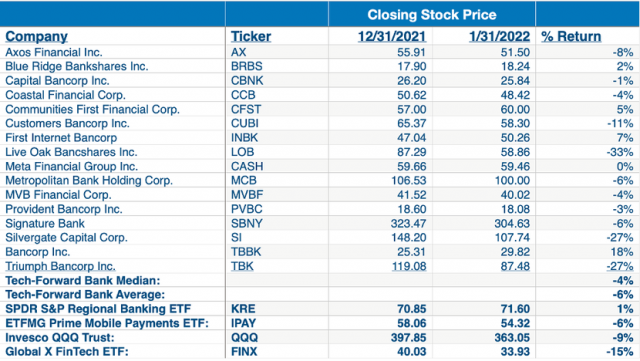Tech-forward bank stocks significantly outperformed traditional banking, tech, and fintech stocks in 2021.
In an article we published just last month, we noted the extraordinary performance of tech-forward bank stocks during 2021, as compared to their more traditional regional and community bank peers. Without rehashing all the details, we’ll simply note the following: bank stocks as a group were among the top-performing sectors of the stock market in 2021, up 36% for the year (as measured by the SPDR S&P Regional Banking ETF), while the 16 publicly-traded tech-forward banks that comprise the Travillian Tech-Forward Bank Index were up 107% on average – roughly 3x the KRE – with returns for each of the 16 stocks exceeding 50%.
Added to that prior analysis in this article (see the chart just below) is the performance of several other representative ETF’s – specifically focused on mobile payments (IPAY), global FinTech (FINX), and QQQ, generally considered to be a proxy for the NASDAQ. IPAY and FINX were lower by 13% and 14% on the year, respectively, while QQQ was up by 27% on the year. The conclusion is clear: the performance of this select group of bank stocks considered to be “tech-forward” far exceeded that of the broader stock market, traditional bank peers, “pure” FinTech and technology stocks, and other niche verticals of tech/FinTech (such as payments).

So far this year, tech-forward bank stocks have underperformed traditional bank peers, but outperformed their “pure” tech and fintech brethern.
So far this year, tech-forward bank stocks have underperformed traditional bank peers, but outperformed their “pure” tech and FinTech brethren.
Through the first month of this new year, as compared to the bank stock index, tech-forward bank stocks have underperformed, though far more modestly than they outperformed during the prior year. While there are some notable exceptions of tech-forward banks that have matched or exceeded the bank sector at large (specifically 4 of the 16 tech-forward banks), on average and based on the median performance, tech-forward bank stocks are down 4% and 6%, respectively, whereas the bank sector index (KRE) is up 1%.
As compared to tech and Fintech peers, however, tech-forward bank stocks have generally outperformed, as evidenced by the performance of the QQQ’s (down 9% during January) and “pure” FinTech (FINX down 15%), while the mobile payments group (IPAY down 6%) is down roughly in line with the decline in the average tech-forward bank stock.

Amidst a market “tug of war” between growth and value, tech-forward bank stocks would seem to represent a hybrid, “best of both worlds” alternative with an attractive risk/reward dynamic.
Amidst a market “tug of war” between growth and value, tech-forward bank stocks would seem to represent a hybrid
After nearly 14 years of growth trumping value, some would argue that we are at, or nearing, an inflection point. Amidst inflation data and other considerations, that would seem to suggest that market interest rates will be on the rise for quite some time, rendering the “growthier” aspects of the market less attractive. Given the numerous head-fakes over the past several years implying that just such an inflection point was close at hand, only to quickly revert to the prior trend, prudence would suggest more of a “wait-and-see approach”. While some prominent market observers believe we could see as many as 7 rate hikes from the Federal Reserve, others think that market dislocation or other factors could force the Fed to alter its course of tightening much sooner. With the caveat that we are not economists, we’re not proponents of either extreme scenario at this point in time – in other words, we think the jury is still out as to how it will all ultimately play out.
For those that believe as we do, we see tech-forward bank stocks as a sort of hybrid alternative to an “all growth” or “all value” approach, allowing investors (generalists in particular) to hedge their bets to either outcome. Recent price action noted above from last year, and so far this year, would seem to bolster this contention: last year, amidst an environment where value-oriented financials were among the best performing market sectors, and “pure”, earlier stage public tech and FinTech stocks struggled, tech-forward bank stocks were standout performers, offering the strong foundational earnings profile of a typical bank and robust growth, at a higher-than-average valuation than a run-of-the-mill bank stock but at a steep discount to pure tech and FinTech peers. Again, just to reiterate, tech-forward bank stocks on average were up by over 100% last year — more than 3x the bank stock index — and as compared to mid-teens percentage declines for pure tech and FinTech peers.
So far year-to-date, the pain facing pure tech and FinTech has only intensified – as an example, FinTech ETF – FINX – fell 15% just in January, exceeding its decline for all of last year in just the first month of trading this year. Traditional bank stocks fared much better and were slightly positive on the month. Tech-forward bank stock performance is best characterized as somewhat of a “middle ground”, underperforming traditional bank peers, but significantly outperforming the pure FinTech peer group and the broader tech sector. That said, we note that the magnitude of the tech-forward bank stock underperformance paled in comparison to the strong outperformance during headier times last year, pointing to what we think is a favorable risk/reward dynamic for this niche.
With the macro backdrop is still so uncertain, tech-forward bank stocks would seem to represent a “best of both worlds”, hybrid alternative to choosing an outright winner of the current tug of war between growth and value. Growth enthusiasts can fulfill their mandate via the robust growth outlook for tech-forward banks, while hedging bets against the carnage that would likely ensue for pure growth stocks in the event of one extreme (7 rate hikes). On the same token, value-oriented investors can hedge their exposure to the opposite macro scenario (Fed reversing course as it has done repeatedly over the past decade), by positioning in tech-forward banks that would likely continue to prosper should we return to the low-rate environment favoring pure growth.












